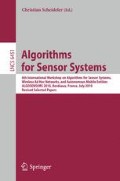Abstract
Consider a wireless sensor network in which each sensor has a bit of information. Suppose all sensors with the bit 1 broadcast this fact to a basestation. If zero or one sensors broadcast, the basestation can detect this fact. If two or more sensors broadcast, the basestation can only detect that there is a ”collision.” Although collisions may seem to be a nuisance, they can in some cases help the basestation compute an aggregate function of the sensors’ data.
Motivated by this scenario, we study a new model of computation for boolean functions: the 2 + decision tree. This model is an augmentation of the standard decision tree model: now each internal node queries an arbitrary set of literals and branches on whether 0, 1, or at least 2 of the literals are true. This model was suggested in a work of Ben-Asher and Newman but does not seem to have been studied previously.
Our main result shows that 2 + decision trees can ”count” rather effectively. Specifically, we show that zero-error 2 + decision trees can compute the threshold-of-t symmetric function with O(t) expected queries (and that Ω(t) is a lower bound even for two-sided error 2 + decision trees). Interestingly, this feature is not shared by 1 + decision trees. Our result implies that the natural generalization to k + decision trees does not give much more power than 2 + decision trees. We also prove a lower bound of \(\tilde{\Omega}(t) \cdot \log(n/t)\) for the deterministic 2 + complexity of the threshold-of-t function, demonstrating that the randomized 2 + complexity can in some cases be unboundedly better than deterministic 2 + complexity.
Finally, we generalize the above results to arbitrary symmetric functions, and we discuss the relationship between k + decision trees and other complexity notions such as decision tree rank and communication complexity.
James Aspnes is supported in part by NSF grant CCF-0916389. Murat Demirbas’ work was partially supported by NSF Career award #0747209. Ryan O’Donnell is supported in part by NSF grants CCF-0747250 and CCF-0915893, a Sloan fellowship, and an Okawa fellowship. Atri Rudra and Steve Uurtamo are supported in part by NSF CAREER grant CCF-0844796.
Access this chapter
Tax calculation will be finalised at checkout
Purchases are for personal use only
Preview
Unable to display preview. Download preview PDF.
References
Aigner, M.: Combinatorial Search. Wiley-Teubner Series in Computer Science (1988)
Arora, A., Dutta, P., Bapat, S., Kulathumani, V., Zhang, H., Naik, V., Mittal, V., Cao, H., Demirbas, M., Gouda, M., Choi, Y.R., Herman, T., Kulkarni, S.S., Arumugam, U., Nesterenko, M., Vora, A., Miyashita, M.: A line in the sand: A wireless sensor network for target detection, classification, and tracking. Computer Networks (Elsevier) 46(5), 605–634 (2004)
Ben-Asher, Y., Newman, I.: Decision trees with boolean threshold queries. J. Comput. Syst. Sci. 51(3), 495–502 (1995)
Ben-Or, M.: Lower bounds for algebraic computation trees. In: STOC 1983, pp. 80–86 (1983)
Bshouty, N.H.: A subexponential exact learning algorithm for DNF using equivalence queries. Information Processing Letters” 59(3), 37–39 (1996)
Buhrman, H., de Wolf, R.: Complexity measures and decision tree complexity: A survey. Theoretical Computer Science 288(1), 21–43 (2002)
Chockler, G., Demirbas, M., Gilbert, S., Lynch, N.A., Newport, C.C., Nolte, T.: Consensus and collision detectors in radio networks. Distributed Computing 21(1), 55–84 (2008)
Demirbas, M., Soysal, O., Hussain, M.: Singlehop collaborative feedback primitives for wireless sensor networks. In: INFOCOM, pp. 2047–2055 (2008)
Dobkin, D., Lipton, R.J.: Multidimensional searching problems. SIAM Journal on Computing 5(2), 181–186 (1976)
Du, D.Z., Hwang, F.K.: Combinatorial Group Testing and its Applications. World Scientific, Singapore (2000)
Dutta, P., Musaloiu-e, R., Stoica, I., Terzis, A.: Wireless ack collisions not considered harmful. In: HotNets-VII: The Seventh Workshop on Hot Topics in Networks (2008)
Ehrenfeucht, A., Haussler, D.: Learning decision trees from random examples. Information and Computation 82(3), 231–246 (1989)
Goodrich, M.T., Hirschberg, D.S.: Efficient parallel algorithms for dead sensor diagnosis and multiple access channels. In: SPAA 2006: Proceedings of the eighteenth annual ACM symposium on Parallelism in algorithms and architectures, pp. 118–127. ACM, New York (2006)
Hamza, K.: The smallest uniform upper bound on the distance between the mean and the median of the binomial and Poisson distributions. Statistics and Probability Letters 23(1), 21–25 (1995)
Jurdzinski, T., Kutylowski, M., Zatopianski, J.: Energy-efficient size approximation of radio networks with no collision detection. In: Ibarra, O.H., Zhang, L. (eds.) COCOON 2002. LNCS, vol. 2387, pp. 279–289. Springer, Heidelberg (2002)
Kushilevitz, E., Mansour, Y.: Learning decision trees using the fourier spectrum. SIAM Journal on Computing 22(6), 1331–1348 (1993)
Kushilevitz, E., Nisan, N.: Communication Complexity. Cambridge University Press, Cambridge (1997)
Moran, S., Snir, M., Manber, U.: Applications of ramsey’s theorem to decision tree complexity. J. ACM 32(4), 938–949 (1985)
Nisan, N.: CREW PRAMs and decision trees. SIAM Journal on Computing 20(6), 999–1007 (1991)
Paturi, R.: On the degree of polynomials that approximate symmetric boolean functions (preliminary version). In: STOC 1992, pp. 468–474 (1992)
Rosenberg, A.L.: On the time required to recognize properties of graphs: a problem. SIGACT News 5(4), 15–16 (1973)
Yao, A.C.C.: Monotone bipartite graph properties are evasive. SIAM Journal on Computing 17(3), 517–520 (1988)
Author information
Authors and Affiliations
Editor information
Editors and Affiliations
Rights and permissions
Copyright information
© 2010 Springer-Verlag Berlin Heidelberg
About this paper
Cite this paper
Aspnes, J., Blais, E., Demirbas, M., O’Donnell, R., Rudra, A., Uurtamo, S. (2010). k + Decision Trees. In: Scheideler, C. (eds) Algorithms for Sensor Systems. ALGOSENSORS 2010. Lecture Notes in Computer Science, vol 6451. Springer, Berlin, Heidelberg. https://doi.org/10.1007/978-3-642-16988-5_7
Download citation
DOI: https://doi.org/10.1007/978-3-642-16988-5_7
Publisher Name: Springer, Berlin, Heidelberg
Print ISBN: 978-3-642-16987-8
Online ISBN: 978-3-642-16988-5
eBook Packages: Computer ScienceComputer Science (R0)

